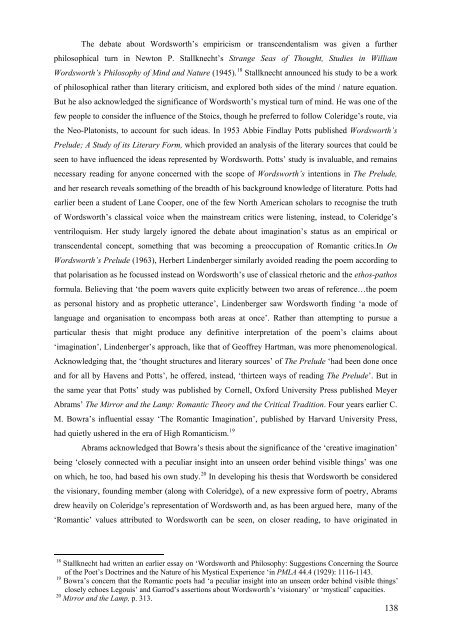Contents - ResearchSpace@Auckland - The University of Auckland
Contents - ResearchSpace@Auckland - The University of Auckland
Contents - ResearchSpace@Auckland - The University of Auckland
You also want an ePaper? Increase the reach of your titles
YUMPU automatically turns print PDFs into web optimized ePapers that Google loves.
<strong>The</strong> debate about Wordsworth’s empiricism or transcendentalism was given a furtherphilosophical turn in Newton P. Stallknecht’s Strange Seas <strong>of</strong> Thought, Studies in WilliamWordsworth’s Philosophy <strong>of</strong> Mind and Nature (1945). 18 Stallknecht announced his study to be a work<strong>of</strong> philosophical rather than literary criticism, and explored both sides <strong>of</strong> the mind / nature equation.But he also acknowledged the significance <strong>of</strong> Wordsworth’s mystical turn <strong>of</strong> mind. He was one <strong>of</strong> thefew people to consider the influence <strong>of</strong> the Stoics, though he preferred to follow Coleridge’s route, viathe Neo-Platonists, to account for such ideas. In 1953 Abbie Findlay Potts published Wordsworth’sPrelude; A Study <strong>of</strong> its Literary Form, which provided an analysis <strong>of</strong> the literary sources that could beseen to have influenced the ideas represented by Wordsworth. Potts’ study is invaluable, and remainsnecessary reading for anyone concerned with the scope <strong>of</strong> Wordsworth’s intentions in <strong>The</strong> Prelude,and her research reveals something <strong>of</strong> the breadth <strong>of</strong> his background knowledge <strong>of</strong> literature. Potts hadearlier been a student <strong>of</strong> Lane Cooper, one <strong>of</strong> the few North American scholars to recognise the truth<strong>of</strong> Wordsworth’s classical voice when the mainstream critics were listening, instead, to Coleridge’sventriloquism. Her study largely ignored the debate about imagination’s status as an empirical ortranscendental concept, something that was becoming a preoccupation <strong>of</strong> Romantic critics.In OnWordsworth’s Prelude (1963), Herbert Lindenberger similarly avoided reading the poem according tothat polarisation as he focussed instead on Wordsworth’s use <strong>of</strong> classical rhetoric and the ethos-pathosformula. Believing that ‘the poem wavers quite explicitly between two areas <strong>of</strong> reference…the poemas personal history and as prophetic utterance’, Lindenberger saw Wordsworth finding ‘a mode <strong>of</strong>language and organisation to encompass both areas at once’. Rather than attempting to pursue aparticular thesis that might produce any definitive interpretation <strong>of</strong> the poem’s claims about‘imagination’, Lindenberger’s approach, like that <strong>of</strong> Ge<strong>of</strong>frey Hartman, was more phenomenological.Acknowledging that, the ‘thought structures and literary sources’ <strong>of</strong> <strong>The</strong> Prelude ‘had been done onceand for all by Havens and Potts’, he <strong>of</strong>fered, instead, ‘thirteen ways <strong>of</strong> reading <strong>The</strong> Prelude’. But inthe same year that Potts’ study was published by Cornell, Oxford <strong>University</strong> Press published MeyerAbrams’ <strong>The</strong> Mirror and the Lamp: Romantic <strong>The</strong>ory and the Critical Tradition. Four years earlier C.M. Bowra’s influential essay ‘<strong>The</strong> Romantic Imagination’, published by Harvard <strong>University</strong> Press,had quietly ushered in the era <strong>of</strong> High Romanticism. 19Abrams acknowledged that Bowra’s thesis about the significance <strong>of</strong> the ‘creative imagination’being ‘closely connected with a peculiar insight into an unseen order behind visible things’ was oneon which, he too, had based his own study. 20 In developing his thesis that Wordsworth be consideredthe visionary, founding member (along with Coleridge), <strong>of</strong> a new expressive form <strong>of</strong> poetry, Abramsdrew heavily on Coleridge’s representation <strong>of</strong> Wordsworth and, as has been argued here, many <strong>of</strong> the‘Romantic’ values attributed to Wordsworth can be seen, on closer reading, to have originated in18 Stallknecht had written an earlier essay on ‘Wordsworth and Philosophy: Suggestions Concerning the Source<strong>of</strong> the Poet’s Doctrines and the Nature <strong>of</strong> his Mystical Experience ‘in PMLA 44.4 (1929): 1116-1143.19 Bowra’s concern that the Romantic poets had ‘a peculiar insight into an unseen order behind visible things’closely echoes Legouis’ and Garrod’s assertions about Wordsworth’s ‘visionary’ or ‘mystical’ capacities.20 Mirror and the Lamp, p. 313.138














